Somaliland: East Africa’s largest conduit for cheetah trafficking to the Gulf.
In late July, two cheetah cubs were rescued from a 25-day ordeal at the hands of wildlife traffickers by the Awdal Region Police in Borama, a city in Somaliland not far from the Ethiopian border. Members of the local community helped look after the dehydrated and underweight cubs until the rescue team arrived. The cubs were then given care by Cheetah Conservation Fund (CCF) staff before being transported to a CCF safe house.
These cubs were part of a series of recent seizures of cheetahs in Somaliland. Through July and August, 20 cheetah cubs were rescued over five missions jointly conducted by the Ministry of Environment and Rural Development, the Selel Regional Administration and the Somaliland Police Force, with support from the CCF and Torrid Analytics. On 14 September, two cheetah cubs were seized in the Sool region in the south-east: the youngest was only 2 weeks old. In total, 25 cubs have been reported as seized or rescued in Somaliland so far this year.1
Cheetah trafficking in Somaliland is not a new issue. Since 2010, when reporting became more consistent, there have been 193 rescued or surrendered cheetahs. Nearly a third of these occurred after the country ratified its Forestry and Wildlife Conservation Law in August 2018, which has reportedly led to increased awareness and better coordination between wildlife officials, police and the army.
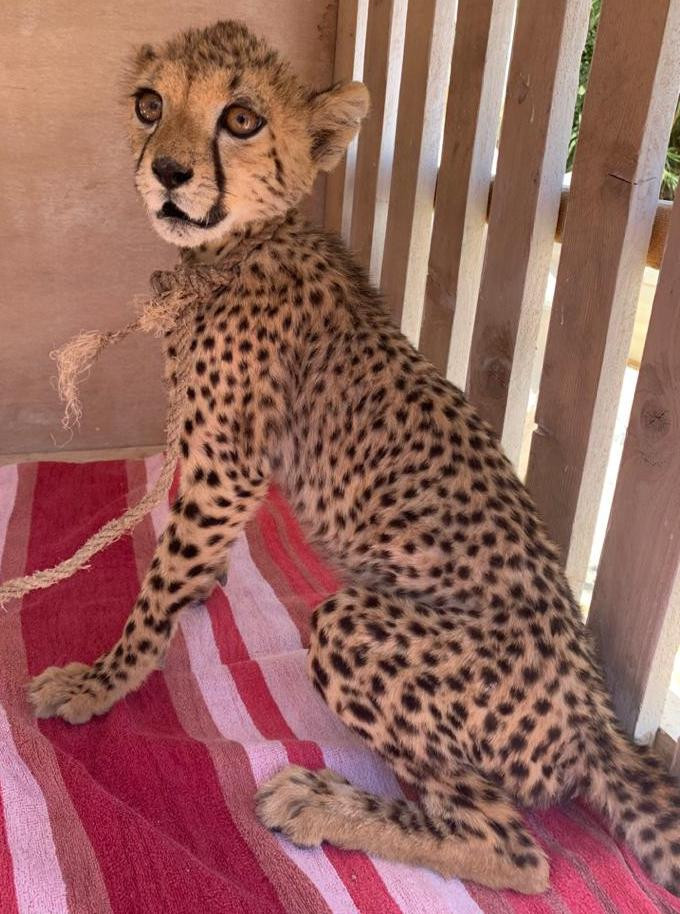
A six-month-old cheetah cub, in the care of Somaliland’s Ministry of Environment and Rural Development and the Cheetah Conservation Fund, en route to Hargeisa, 29 July 2020. The cub was one of eight rescued over three missions in Somaliland in late July.
SOURCE: Cheetah Conservation Fund
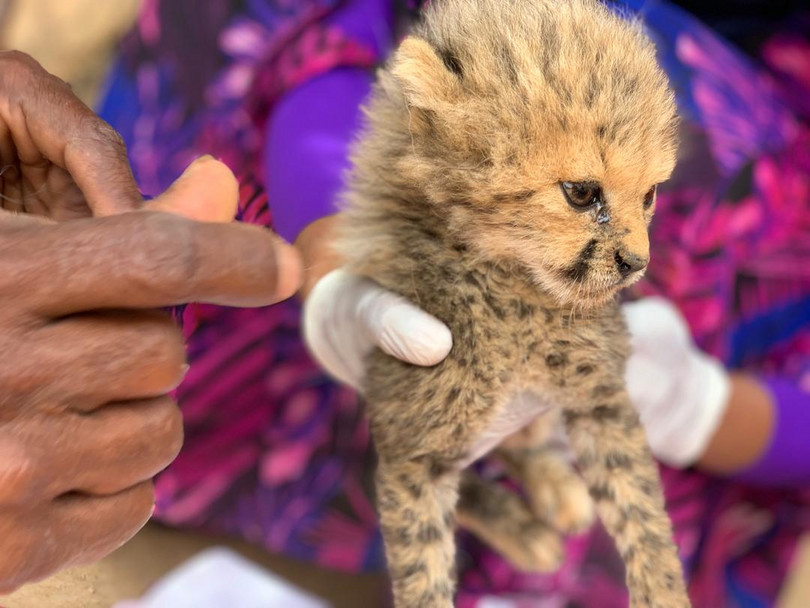
A cheetah cub receives care from representatives of Somaliland’s Ministry of Environment and Rural Development, in a village near Erigavo, Sanaag, in August 2020. According to reports, the cubs were being held by local farmers who surrended them to the authorities, as the result of conflict with the mother cheetah near their livestock.
SOURCE: Ministry of Environment and Rural Development (via Twitter)
Many of the cheetahs seized in Somaliland are believed to originate in Ethiopia, which shares a 500-mile border with the self-declared state. At least 25% of seized cheetahs in Somaliland have been found at or near the Ethiopian border – the two cubs intercepted near Borama in August, for example, were less than 15 kilometres from the border. As known cheetah populations in Ethiopia total no more than 300 adolescent and adult specimens,2 it is clear that the trafficking of cheetah cubs is taking a significant toll on cheetah populations. Ethiopia and South Sudan, along with Somalia/Somaliland where cheetah populations are unknown, are also the last remaining stronghold of the North East African cheetah subspecies, A.j. soemmeringii.3
Cheetah cubs are mostly taken from the wild when the mother hides them to go hunting, either opportunistically by nomad herders or by poachers. A cub can sell for between US$200 and US$300 in Somaliland, although prices vary greatly: an unhealthy cub can be bought for as little as US$80, while a healthy, older cub can cost up to US$1 000.4 The same cheetah can be sold for up to US$15 000 in the Gulf states. Mortality is high, as most cubs are removed from the wild at only two to eight weeks from birth and are subjected to maltreatment and poor nutrition in the hands of poachers and dealers, compounded with the rigours of the trip across the Gulf of Aden. While difficult to estimate, it is thought that over 60% of cheetah cubs die before they reach the market to be sold.5
Somaliland is vulnerable as a conduit for the illegal wildlife trade not only due to its proximity to the Arabian Peninsula’s wealthy consumer markets for exotic wildlife, but also due to the country’s rampant poverty, weak legal frameworks and a lack of environmental awareness. Corruption also drives the cheetah trade, as evidenced by illegally obtained cheetah cubs being sold back to smugglers by corrupt officials after a confiscation have been reported.6 That being said, Somaliland’s cheetah trade has been more extensively researched than other countries and regions of Somalia. Its relative importance as the main cheetah-trafficking route into the Middle East might be in part connected to underreporting from other countries.
Across the Gulf of Aden
From Somaliland, cheetahs are transported by boat – hidden in hampers, crates or cardboard boxes – from the northern coastline across the Gulf of Aden to Yemen at an estimated rate of 300 cubs per year.7 The 140 nautical miles between the ports of Berbera in Somaliland and Aden in Yemen can be covered in just over seven hours at a dhow’s average speed of 20 knots.
Once in Yemen, cheetahs are reportedly transported by boat or road across the Saudi border to animal markets such as Al-Jazan or Al-Khouba, or delivered to Saudi traders, who will then offer them throughout the Gulf states to known buyers on ecommerce and social-media platforms such as Instagram and Snapchat, or, more recently, through private chat groups. One study found that at least 2 000 cheetahs had been advertised online between 2010 and 2019.8 Most were found on Instagram, with sellers offering cheetahs in Saudi Arabia, the UAE and Kuwait.
Figure 4 Number of live cheetahs involved in trafficking incidents in eastern and southern Africa, 2010 to 31 July 2018. Includes instances where the animals involved could be seized from traffickers, and those where cheetahs were observed to be trafficked but interception was not possible. ‘Other’ includes incidents recorded in Botswana, Namibia, Tanzania, South Africa, Uganda, Djibouti, Kenya and Zimbabwe.
Note: Data compiled from records of CCF fieldwork, official channels (CITES, governments and government–NGO partnerships); personal correspondence with other NGOs and observers in the field (such as veterinarians); and media reporting and internet searches. Within these sources, reports are checked for veracity through interviews, online searches for official records, or digital evidence (video, images). Every effort was made to include only data confirmed by two such independent sources.
SOURCE: Patricia Tricorache, CCF
Figure 5 Number of live cheetahs seized from traffickers by law enforcement or surrendered in Somaliland, 2010 to 14 September 2020.
SOURCE: P. Tricorache, et al, Pets and pelts: Understanding and combating poaching and trafficking in cheetahs, in L. Marker, L. Boast & A. Schmidt-Küntzel (eds), Cheetahs: Biology and Conservation, 2017, http://www.felidae.org/Tricorache%20et%20 al%202017.pdf; CITES Parties Kenya and Ethiopia, Illegal Trade in Cheetahs: Supplemental Information and Recommendations, Annex 1, 18th meeting of the Conference of the Parties, 17–28 August 2019, https://cites.org/sites/default/files/eng/cop/18/inf/E-CoP18-Inf-073.pdf; P Tricorache, data compiled from reporting of seizures by the Somaliland authorities.
Delivery to the UAE, Qatar or Kuwait from Saudi Arabia can be made by road or air.9 An investigative report published by Le Figaro quoted an employee at the Kuwait airport who stated that:
It is enough to mention that they are ‘cats’ on the box and to pay certain people I know. It is easy for me because I work there and I know who will take the money. I give them between KWD 500 and KWD 1000 [US$1 600–US$3 200] to allow illegal animals [through the country].10
There have also been isolated reports of cheetahs arriving in Oman from Yemen, as well as being transported from Oman into the UAE via the Hatta border crossing.
An illegal status symbol
Cheetahs have long been popular household pets or hunting companions in the Gulf states, where they are viewed as status symbols. This popularity has been boosted in recent years by wealthy or famous individuals posing with their exotic pets on social media.11 However, few cheetah owners know how to provide the proper care for these animals, with some social-media posts advertising cheetahs that have been declawed – an extremely painful process for the animals. Many pet cheetahs in the Gulf states do not live beyond the first year, and few live longer than five years.12
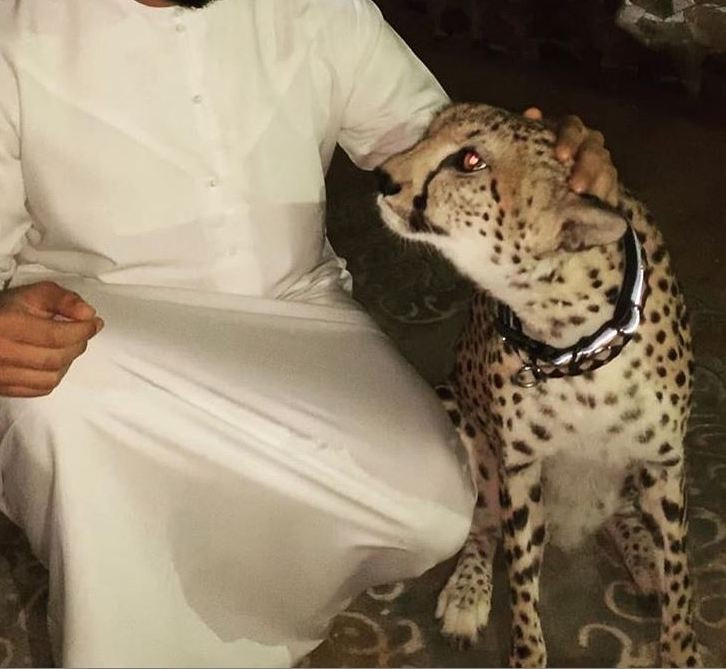
An instagram user in Dubai poses with a pet cheetah.
SOURCE: Social media
Trade in wild cheetahs for commercial purposes is illegal in all the Gulf states, either through the states being party to the Convention on International Trade in Endangered Species of Wild Fauna and Flora (CITES) or through domestic legislation.13 In December 2016, the UAE enacted a law banning the private possession of exotic and dangerous pets, although only one seizure (of four cheetahs) has been made since 2015,14 suggesting that the ban is seldom enforced. In Kuwait, where no cheetahs have been seized in the past 5 years, the National Assembly approved a draft animal-welfare law that penalizes illegal trade or possession of predators in December 2015.15 In Qatar – where discussions continue over a law regulating the trade and ownership of dangerous animals – the Ministry of Municipality and Environment announced the arrest of an Arab national in July 2016 for trading in cheetahs.16
Under CITES regulations, however, captive-bred cheetahs can be traded commercially by registered facilities.17 The CITES Trade Database reports that 16 ‘captive-bred’ cheetahs were exported into Armenia from Bahrain and the UAE between 2009 and 2015.18
However, the probability that cheetahs in the Gulf (both those kept as pets and those exported) are truly bred in captivity or traded in compliance with national laws or CITES regulations is low. Firstly, only two such registered breeding facilities exist worldwide – both are in South Africa. Secondly, cheetahs do not breed well in captivity. Based on information from the International Cheetah Studbook, a voluntary register of captive cheetahs worldwide, the first report of captive-bred cheetahs in the Gulf states was in 1994. Since then, six facilities have reported a total of 304 cheetah births in captivity, with a 31% mortality rate for cubs under six months. No births have been reported by these facilities since 2016.19
It is therefore more likely that purportedly ‘captive-bred’ cheetahs in the Gulf in fact come from elsewhere, as suggested by the ‘captive-bred’ cheetahs exported from Bahrain to Armenia. There are no known cheetah-breeding facilities in Bahrain, suggesting that the cheetahs’ real origins were masked.20
A contentious issue
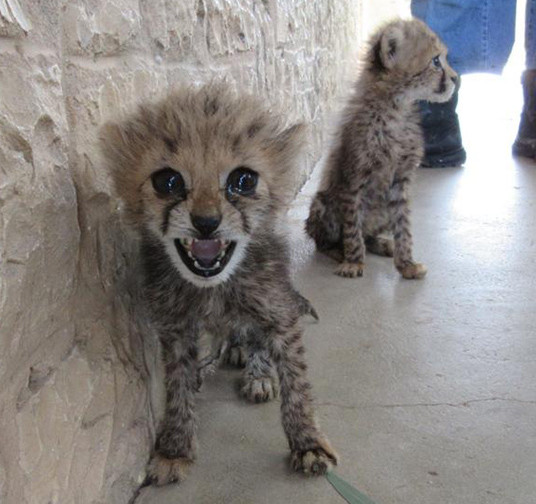
Two cubs rescued near Borama, 24 July 2020. The cubs had reportedly been in the hands of traffickers for 25 days before their rescue.
SOURCE: CCF
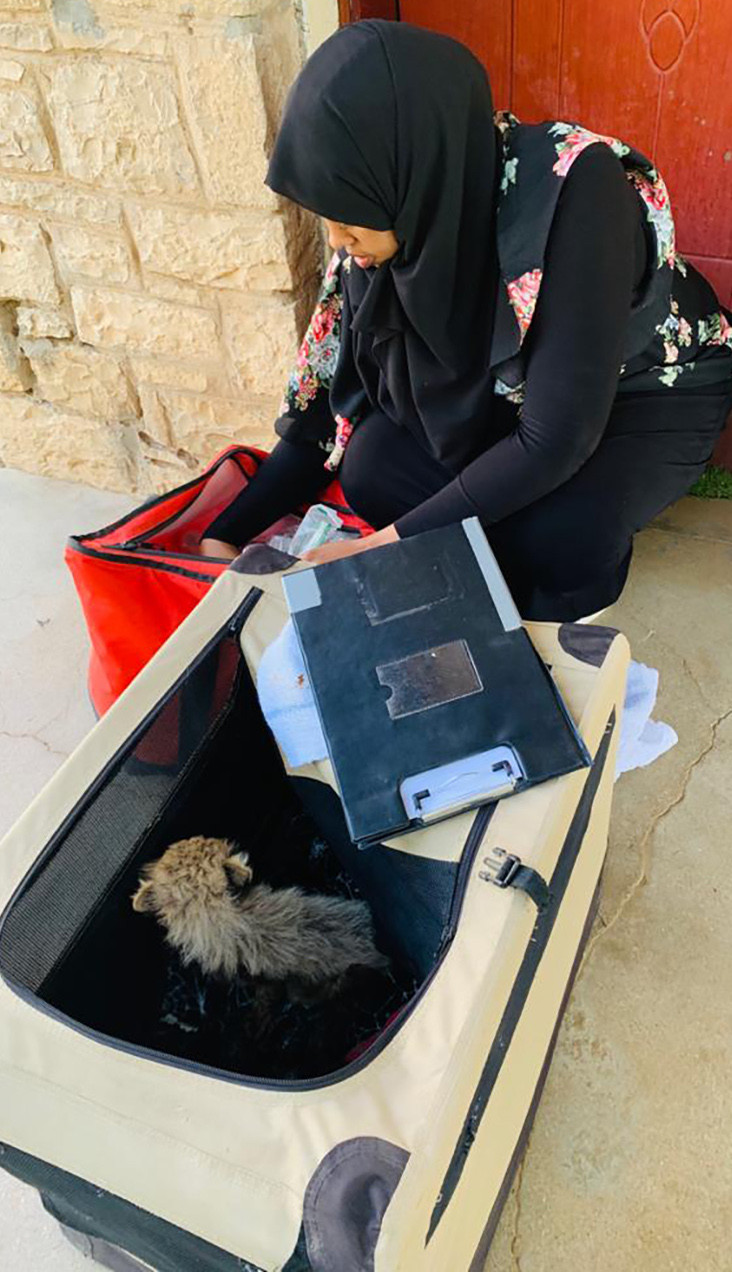
CCF veterinarian Dr Asma Bile prepares cubs rescued from traffickers to make the journey to Hargeisa to the CCF safe house.
SOURCE: CCF
The issue of the illegal cheetah trade has been on the CITES agenda since 2013, when it commissioned a study that led to decisions and recommendations aimed at reducing demand and encouraging international collaboration. However, the 18th Conference of the Parties (CoP), held in August 2019, voted to delete these decisions based on a report from the Standing Committee to the Secretariat.21 The report concluded that illegal cheetah trade was limited, based on official seizure reports from nine countries that cited 32 specimens (13 live, 19 parts or products) between 2015 and mid-2018. Based on this, the CoP agreed that matters related to illegal cheetah trade could be addressed by a Big Cat Task Force, jointly run by CITES and the Convention for Migratory Species, which is currently in the process of being implemented.
However, Kenya and Ethiopia – two cheetah-range countries – argued that the numbers reported by CITES ‘underestimate the full extent of the trade, since they only include confiscated animals appearing in official records and omit data from many countries, including key primary source countries for trafficked cheetah’. 22 They cited information showing 393 cheetah specimens (274 live animals and 119 parts), including the 32 seized specimens reported to CITES, during the same period.
The countries’ joint statement – submitted to the CITES CoP – went on to add: ‘Given the perilous state of [East African] cheetah populations that are the source of illegal trade, any ongoing trade in wild cheetah is alarming.’
The recent spate of seizures in Somaliland seems to confirm those fears. The illegal trade in wild cheetahs appears to be continuing apace, with potentially grave consequences for East African cheetah populations.
Notes
-
Data on seizures in Somaliland was compiled from various sources, including social-media posts by officials of the Somaliland Ministry of Environment and Rural Affairs (https://twitter.com/AbdinasirAHers1, https://www.facebook.com/car.kudhac) and the Cheetah Conservation Fund (https://www.facebook.com/CCFcheetah, https://twitter.com/ccfcheetah). ↩
-
Sarah M. Durant et al., The global decline of cheetah Acinonyx jubatus and what it means for conservation, Proceedings of the National Academy of Sciences of the United States of America, 114, 3, 528–533. ↩
-
Laurie Marker, Cheetah rangewide status and distribution, in Cheetahs: Biology and Conservation, ed. Laurie Marker, Lorraine Boast and Anne Schmidt-Küntzel. Acadmic Press, 2018, pp. 33–54. ↩
-
Patricia Tricorache et al., Pets and pelts: Understanding and combating poaching and trafficking in cheetahs, in Cheetahs: Biology and Conservation, ed. Laurie Marker, Lorraine Boast and Anne Schmidt-Küntzel. Acadmic Press, 2018, pp 191–205. ↩
-
Simon Worral, This impoverished region is a hub for the cheetah trade. Now it’s fighting back., National Geographic, 4 December 2018, https://www.nationalgeographic.com/animals/2018/11/fighting-cheetah-trade-somaliland/. ↩
-
Patricia Tricorache et al., Pets and pelts: Understanding and combating poaching and trafficking in cheetahs, in Cheetahs: Biology and Conservation, ed. Laurie Marker, Lorraine Boast and Anne Schmidt-Küntzel. Acadmic Press, 2018, pp 191–205. ↩
-
Kristin Nowell, An assessment of conservation impacts of legal and illegal trade in cheetahs acinonyx jubatus, CITES Standing Committee, 2014, https://cites.org/sites/default/files/eng/com/sc/65/E-SC65-39.pdf. ↩
-
Patricia Tricorache, During my research I have identified at least 2,000 cheetahs for sale online between 2010 and 2019. I stopped reporting them because when I did, the evidence simply got destroyed without anyone taking action to investigate and prosecute, LinkedIn post [Patricia Tricorache], August 2020. (Unpublished data.) ↩
-
Al-Rai, Cheetahs trade ‘a fast rising business’ in Kuwait, Kuwait Times, 31 October 2012. ↩
-
Quentin Müller, Au Koweït, un important trafic de guépards de compagnie, Le Figaro, 23 August 2017, https://www.lefigaro.fr/sciences/2017/08/22/01008-20170822ARTFIG00220-au-koweit-un-important-trafic-de-guepards-de-compagnie.php. ↩
-
Leonarda Spee et al., Endangered exotic pets on social media in the middle east: Presence and impact, Animals, 9, 8, https://doi.org/10.3390/ani9080480. ↩
-
Cheetah Conservation Fund, unpublished data. ↩
-
CITES, Convention on International Trade in Endangered Species of Wild Fauna and Flora (CITES), Environmental Poicy and Law, 13, 3–4, p 130. 6 ↩
-
Al Ain takes in four confiscated cheetah cubs, Emirates Newswire, 1 March 2020, https://emiratesnewswire.ae/al-ain-zoo-takes-in-four-confiscated-cheetah-cubs/. ↩
-
Assembly approves animal rights bill, Kuwait News Agency, 16 December 2015, http://www.kuna.net.kw/ArticleDetails.aspx?id=2478212&language=en. ↩
-
Qatar Ministry of Municipality and Environment (Qatar) [@albaladiya], The Department of Environmental Protection, Sanctuaries and Wildlife apprehends a person who trades in dangerous animals ‘cheetah’ and takes the necessary measures, Twitter post, https://twitter.com/albaladiya/status/755990541754564608. ↩
-
Article VII, paragraph 4, of CITES states that ‘Specimens of an animal species included in Appendix I bred in captivity for commercial purposes … shall be deemed to be specimens of species included in Appendix II’. In Resolution Conf. 12.10 (Rev. CoP15) on Registration of Pperations that breed Appendix-I animal species in captivity for commercial purposes, the Conference of the Parties to the Convention has agreed to an interpretation of the provision, as follows: ‘Parties shall restrict imports for primarily commercial purposes, as defined in Resolution Conf. 5.10 (Rev. CoP15), of captive-bred specimens of Appendix-I species to those produced by operations included in the Secretariat’s Register and shall reject any document granted under Article VII, paragraph 4, if the specimens concerned do not originate from such an operation and if the document does not describe the specific identifying mark applied to each specimen.’ ↩
-
CITES Trade Database search for live cheetahs imported by Armenia between 1975 and 2020, https://trade.cites.org/. ↩
-
Laurie Marker and Becky Johnston, (International Cheetah (Acinonyx jubatus) Studbook, Cheetah Conservation Fund, 2018, https://cheetah.org/wp-content/uploads/2019/12/Complete-Studbook-2018.pdf. ↩
-
Kristine Aghalaryan, Endangered animal trafficker, wanted by Interpol, continues doing business in Armenia, HETQ, 11 January 2016, https://hetq.am/en/article/64931. ↩
-
CITES, Illegal Trade in Cheetahs (Acinonyx Jubatus), Report to the Secretariat. SC70 Doc. 43, Seventieth meeting of the Standing Committee, 1–5 October 2018. ↩
-
Kenya and Ethiopia, Illegal Trade in Cheetahs: Supplemental Information and Recommendations, CoP 18 Inf. 73, Eighteenth meeting of the Conference of the Parties, Geneva, Switzerland, 17–28 August 2019. ↩
